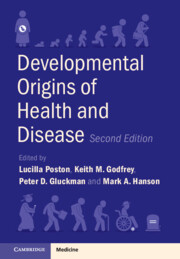Book contents
- Developmental Origins of Health and Disease
- Developmental Origins of Health and Disease
- Copyright page
- Contents
- Contributors
- Preface
- Section I Overview
- Section II Exposures Driving Long-Term DOHaD Effects
- Section III Outcomes
- Section IV Mechanisms
- Section V Interventions
- Section VI Public Health and Policy Implications of Interventions
- Chapter 19 Education and Science Communication
- Chapter 20 DOHaD: Engaging with New Global Issues to Inform Policy
- Index
- References
Chapter 20 - DOHaD: Engaging with New Global Issues to Inform Policy
from Section VI - Public Health and Policy Implications of Interventions
Published online by Cambridge University Press: 01 December 2022
- Developmental Origins of Health and Disease
- Developmental Origins of Health and Disease
- Copyright page
- Contents
- Contributors
- Preface
- Section I Overview
- Section II Exposures Driving Long-Term DOHaD Effects
- Section III Outcomes
- Section IV Mechanisms
- Section V Interventions
- Section VI Public Health and Policy Implications of Interventions
- Chapter 19 Education and Science Communication
- Chapter 20 DOHaD: Engaging with New Global Issues to Inform Policy
- Index
- References
Summary
As noted in Chapter 1, it is now over two decades since the field of DOHaD was established, as an extension of the epidemiological findings of Barker and colleagues and their integration with new ideas in developmental physiology, evolutionary biology and medicine. Despite the widespread acceptance of both the underlying science and phenomena of DOHaD, as evidenced in each of the previous 19 Chapters of this book and the range of scientists now engaged in relevant research, the field has had less impact than it warrants on public health, clinical practice or public policy. Here, we review the reasons for this, and suggest some possible solutions.
- Type
- Chapter
- Information
- Developmental Origins of Health and Disease , pp. 213 - 220Publisher: Cambridge University PressPrint publication year: 2022



